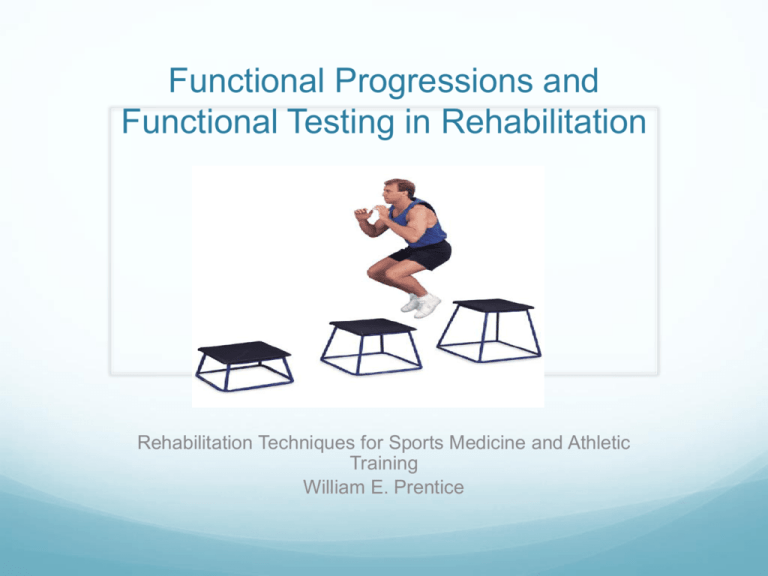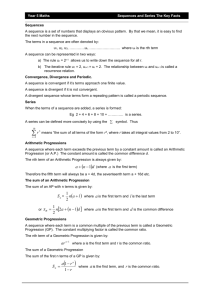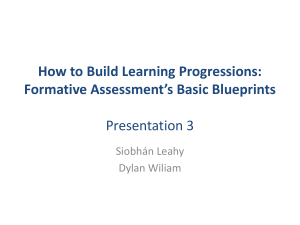Functional Progression
advertisement

Functional Progressions and Functional Testing in Rehabilitation Rehabilitation Techniques for Sports Medicine and Athletic Training William E. Prentice Introduction To reduce lasting effects of injury, athletic trainer should direct rehabilitation toward improving neuromuscular coordination and agility as well as strength and endurance Return athlete to pre-injury activity levels Function refers to patterns of motion that use multiple joints acting with various axes and multiple planes Focus on functional rehabilitation will ready patient for activity and competition Role of Functional Progressions in Rehabilitation A.T. must adapt rehabilitation to the sports specific demands of each individual sport and position Functional Progression Succession of activities that simulate actual motor and sport skills Enable patient to acquire or reacquire skills needed to perform athletic endeavors safely and effectively Places stresses and forces on each body system in a well-planned positive and progression fashion Improves patients overall ability to meet the demands of daily activities as well as sport competition Role of Functional Role of Functional Progressions in Rehabilitation A.T. breaks down activities involved in a given sport into individual components Patient concentrates on components in a controlled environment before combining them together in an uncontrolled environment Essential in the rehabilitation process Tissues not placed under performance level stresses do not adapt to the sudden return of such stresses when full activity is resumed Benefits of using Functional Progressions Assist patient and A.T. in reaching the goals of the entire program Restoration of joint ROM Strength Proprioception Agility Confidence Allow patient to reach desired level of activity safely and effectively Physical Benefits Improving functional stability Maintained by neuromuscular control mechanisms involved in proprioception and kinesthesia Performance during functional task can be evaluated and corrected Functional testing can be used to provide objective measure of ability Muscle strength Muscles involved will be strengthened dynamically under stresses similar to those encountered in competition Using SAID and Overload Principles Endurance Muscular and cardiorespirtaory endurance can be enhanced with functional progressions Through repetition of of individual activities and their combination into one general activity Physical Benefits Flexibility Injured area stressed within a controlled range during functional progression Improved mobility and flexibility crucial to patient return to activity Strength and endurance do not mean much if injured area cannot move through normal ROM Muscle relaxation Functional progression can teach an individual to recognize muscle tension and eventually control or remove it by relaxing muscles after exercise Relieve muscle guarding that may inhibit normal ROM Physical Benefits Motor Skills Coordination, agility and motor skills are complex aspects of normal function Needed to transform strength, flexibility and endurance into full-speed performance Repetition and practice are are important to learning motor skills Rehabilitation exercises must stress neuromuscular coordination and agility to increase performance and decrease chance of reinjury Develop automatic reactions needed during activity Psychological Benefits Functional progression can help reduce common emotions found after injury Anxiety Athlete gradually placed into more demanding situations. Experience success and not be as concerned with failure Deprivation Athlete can engage in activity during practice to remain close in proximity and socially feel little loss in team cohesion Apprehension Enable patient to adapt to imposed demands of their sport in a controlled environment Restore confidence Components of a functional progression Four principles Individuality of the patient, sport and the injury Activities should be positive not negative; no increase in signs or symptoms Orderly progressive program Program should be varied to avoid monotony Vary exercise techniques Alter the program at regular intervals Maintain fitness base Set achievable goals , reevaluate, and modify regularly Use clinical, home and on field programs Use sport specific activities to enhance patients return to activity Designing a Functional Progression No cookbook, be creative and specific to athletes goals and injury status Progressions should start early in rehab Start with low impact and progress to high impact Assess athlete periodically to determine ability to progress to next exercise Achieving a certain skill level occurs when a the skill can be completed at functional speed with high repetition without increase in pain, swelling or a decrease in ROM Functional Testing Patient performs certain tasks appropriate to their stage in rehab Isolate specific deficits A.T. able to determine current functional level and set functional goals Indirect measure of muscular strength and power Uses maximal performance of an activity Provide A.T. with objective data Functional Testing Three purposes Determine risk of injury due to limb asymmetry Provide objective measure of progress during rehab plan Measure the ability of the individual to tolerate forces Functional Testing A.T. must evaluate what test will be used Validity : test should measure what it intends to measure Reliability: Test should consistently provide similar results regardless of evaluator Observe unilateral and bilateral function to determine compensation patterns A.T. should also consider stage of healing, strength, patients ability and physician approval Functional Testing Preseason baseline measurements are preferred so A.T. has data to compare post injury activity levels Not always obtained by A.T., however individual sports may do baseline testing With or without baseline measurements a score of 85% or better compared to noninjured side is recognized as standard for limb symmetry scores Functional Testing Uses functional progression drills for the purpose of assessing the athlete’s ability to perform a specific activity Entails a single maximal effort to gauge how close the athlete is to full return Pre-season baseline testing for comparison post injury Variety of tests Shuttle runs -Vertical jumps Agility runs -Balance Figure 8’s -Hopping for distance Carioca tests -Co-contraction test Lower Extremity Functional Progression Walking: Normal Gait Walking: Heels walks Walking: Toe walks Side step/Shuffle Lunge 90° to Lunge 180° Step ups forward to lateral step ups Increase speeds Jogging Begin straight ahead, gradually increase intensity 50%100% Introduce curves: Oval,“S” course, figure “8” course, “Z” course Sprint Straight ahead varying intensities Add acceleration/deceleration drills Box Runs Carioca Hopping: Double Leg to Single Leg to Alternate Jumping: Plyometrics Progress intensities Sport specific Speed and Agility drills: Sport specific Ladder drills Cutting, jumping on command Position specific activities Upper Extremity Functional Progression Assisted PNF techniques T-band exercises simulating specific sport/position motions Strength and endurance Closed chain exercises: Push up progression Upper Body Plyometrics Interval throwing program Focus on mechanics and biomechanical dysfunctions Begin with general warm up Step 1: 45 ft. phase Warm up throwing 25 throws Rest 10 minutes Warm up throwing 25 throws Step 2: 45 ft. phase Warm up throwing’ 25 throws 15 minute rest Warm up throwing 25 throws Rest 10 minutes Warm up throwing 25 throws Repeat steps 1 & 2 for 60, 90, 120, 150, 180 ft. Only progress if pain free and no signs or symptoms develop When program completed move to position specific throwing For example: pitcher throw off mound Designing a Functional Progression Full Return to Play Physicians release Pain free No Swelling Normal ROM Normal strength (in reference to contralateral limb) Appropriate functional testing completed with no adverse reactions



